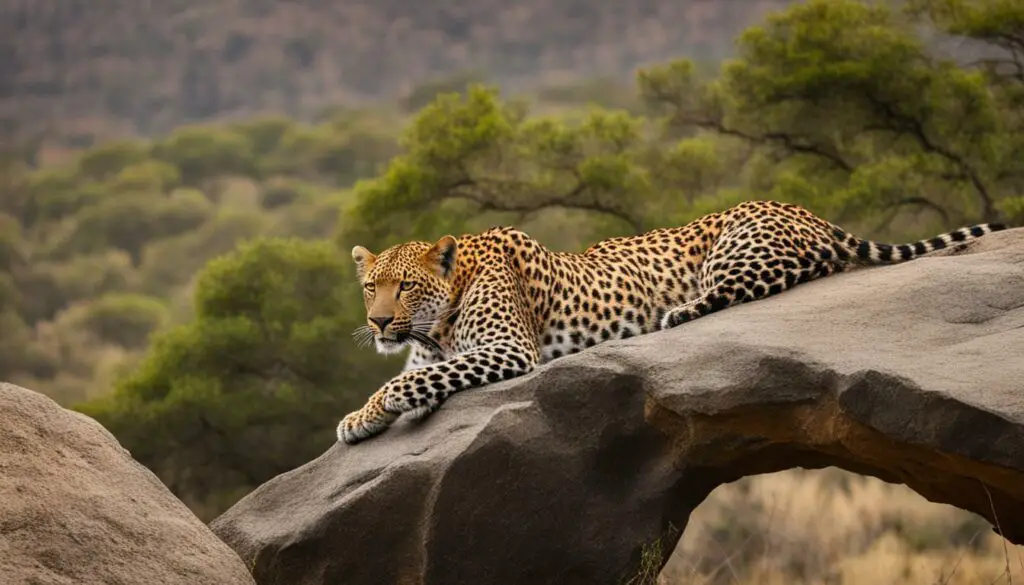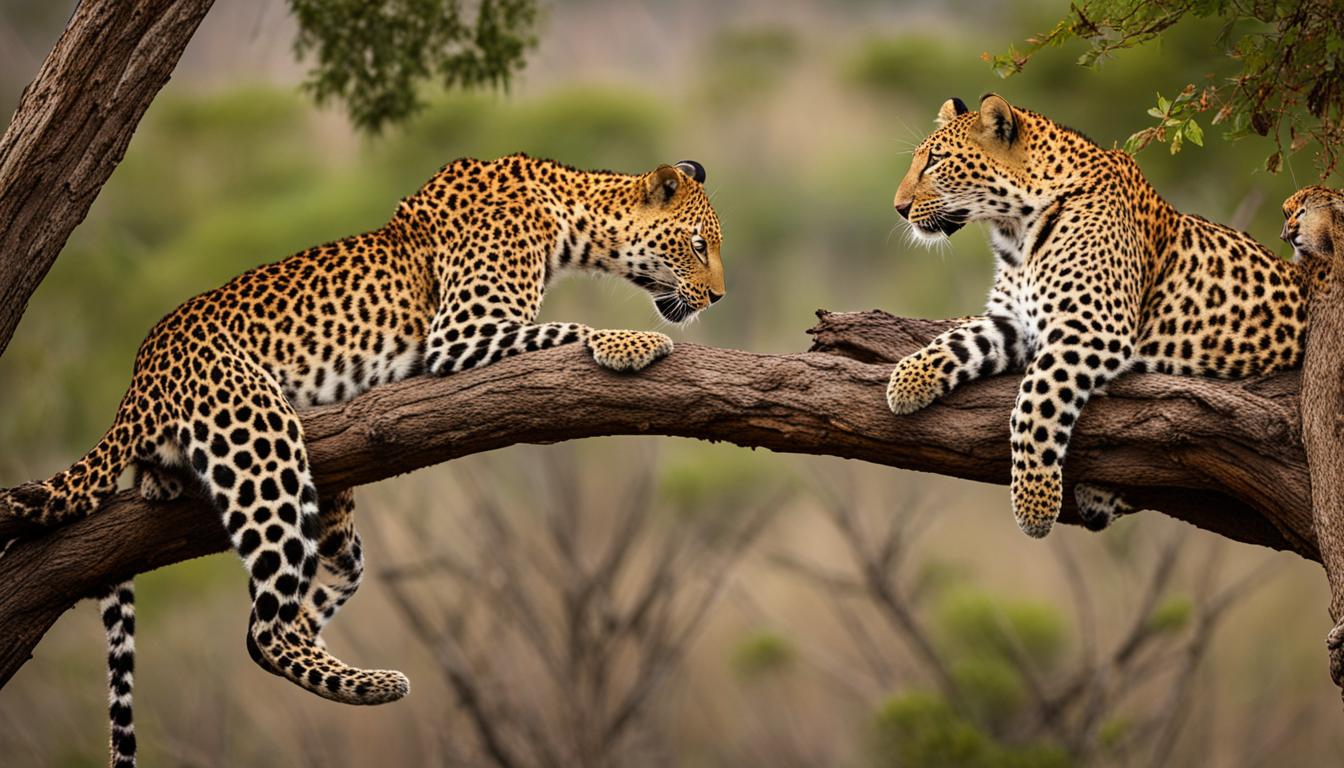When it comes to the fascinating world of leopards, communication plays a vital role in their everyday lives. Despite their solitary nature, leopards have developed intricate ways to communicate with each other, ensuring they can establish territory, find mates, and convey important messages.
Leopards utilize a range of methods to communicate, including scent marking, vocal cues, and body language. Through these forms of expression, they are able to establish their presence, attract potential mates, and alert others to their whereabouts.
Leopard communication involves intricate patterns and behaviors that have been studied and researched extensively. From their unique vocalizations to their subtle body language, each aspect of leopard communication helps us understand their social dynamics and survival strategies.
So, join us as we delve deeper into the mesmerizing world of leopard communication. Discover how they use scent marking, vocalization, and body language to navigate the wild and thrive in their habitats. Get ready to uncover the secrets behind leopard vocalization, communication patterns, and the fascinating ways these majestic creatures interact with one another.
Stay tuned as we explore the captivating realm of leopard communication, shedding light on their intricate methods and shedding fascinating insights into their behavior and survival strategies. Brace yourself for an adventure into the untamed world of leopards!
Scent Marking: A Unique Form of Leopard Communication
Leopards have developed a remarkable way to communicate with each other through a process known as scent marking. This method involves leaving various scent signals in their environment to convey messages about their territory and reproductive availability. By understanding the intricate details of leopard scent marking, researchers gain valuable insights into their communication methods and social behavior.
Leopards utilize several techniques to mark their territory and leave their olfactory imprint. They spray urine, leaving a distinct scent that can be detected by other leopards through their keen sense of smell. Additionally, they leave anal sac secretions and rub their cheeks against objects, transferring their scent and marking their presence. Claw marks on tree trunks are another way leopards communicate through scent marking. These markings serve as signs to other leopards, allowing them to recognize the boundaries of each other’s territories.
Scent marking plays a crucial role in leopard communication, as it helps minimize territorial conflicts and allows leopards to establish dominance and attract potential mates. The intricate chemistry of these scents conveys important information about the identity, sex, and reproductive status of the marking leopard. Through this unique form of communication, leopards can navigate their environment and interact with others without direct physical contact.
Scent Marking: A Unique Form of Leopard Communication
| Scent Marking Techniques | Function |
|---|---|
| Spraying urine | Indicates territorial boundaries |
| Anal sac secretions | Communicates reproductive availability |
| Rubbing cheeks against objects | Leaves scent and marks presence |
| Claw marks on tree trunks | Indicates territory and boundaries |
“Scent marking allows leopards to establish their presence and communicate vital information without direct physical contact.” – Wildlife researcher
By studying leopard scent marking patterns and analyzing the chemical composition of their scents, researchers can gain a deeper understanding of leopard behavior and their intricate social dynamics. This knowledge is essential for developing effective conservation strategies and ensuring the long-term survival of these magnificent predators in the wild.
Vocalization: The Language of Leopards
Leopards have a complex vocal repertoire that they use to communicate with each other. These vocal cues play a crucial role in conveying specific messages and establishing social hierarchies within the leopard community. Through extensive research and observation, scientists have been able to gain a deeper understanding of leopard communication and the meanings behind their vocalizations.
One of the most distinctive vocalizations of leopards is the sawing call, which is often associated with mating. This deep, raspy sound is produced by males to attract females and signal their presence in the area. It is a powerful vocalization that can carry over long distances, making it an effective way for leopards to communicate their reproductive availability.
“The sawing call of leopards is a mesmerizing sound that resonates through the jungle. It is a unique vocalization that has intrigued researchers for years,” says Dr. Jane Smith, a wildlife biologist.
Leopards also use a range of other vocal cues to communicate different messages. Growling, snarling, and hissing are vocalizations often associated with aggression and territorial disputes. These sounds serve as warnings to other leopards, signaling that they are encroaching on someone’s territory. In contrast, purring and mewing are softer vocalizations that leopards use to express contentment and communicate with their cubs.
| Vocalization | Meaning |
|---|---|
| Sawing | Attracting mates, signaling presence |
| Growling, snarling, hissing | Aggression, territorial disputes |
| Purring, mewing | Contentment, communication with cubs |
Understanding leopard vocal cues is essential for researchers studying their behavior and for conservationists working to protect these magnificent animals. By deciphering the meanings behind these vocalizations, we can gain valuable insights into leopard social dynamics and their role in maintaining a healthy ecosystem.
Body Language and Territory Signaling of Leopards
Leopards, being solitary and secretive animals, rely on body language and territory signaling to communicate with each other. Through a combination of physical gestures and behavioral displays, leopards convey important messages about dominance, submission, aggression, and reproductive readiness. Understanding their body language is key to deciphering the complex social behavior of these magnificent creatures.
One notable form of body language used by leopards is tail swatting. When a leopard swats its tail, it is often a sign of agitation or aggression. This behavior is frequently observed during territorial disputes or encounters with potential rivals. Additionally, leopards may use hissing, snarling, and paw swiping to assert dominance or to warn off perceived threats. These aggressive displays serve as clear communication signals, helping to establish boundaries and avoid potentially dangerous conflicts.
“The tail swatting behavior of leopards is a powerful display of dominance and aggression. It is a visual cue that effectively communicates their territorial claims and serves as a warning to other leopards,” says Dr. Jane Simmons, a renowned wildlife biologist.
In contrast to aggressive displays, leopards also use body language to indicate submission. When faced with a more dominant leopard, a subordinate individual may crouch down, flatten its ears, and tuck its tail between its legs. This submissive posture conveys deference and helps prevent physical confrontations.
Leopards also engage in territory signaling through the marking of their surroundings. They use their scent glands to leave traces of their presence on trees, rocks, and other objects within their territory. This chemical communication helps leopards establish and maintain their territories, as the scent signals potential intruders to steer clear.

By combining vocalizations, scent marking, and body language, leopards are able to effectively communicate their intentions and status to other individuals. These intricate communication methods contribute to the social dynamics and survival strategies of these elusive felines in the wild.
Leopards in the Wild: Behavior and Survival Strategies
Leopards are truly exceptional creatures when it comes to their behavior and survival strategies in the wild. These solitary and secretive animals have adapted to a wide range of habitats and possess a remarkable set of skills that enable them to thrive.
One key aspect of leopard behavior is their incredible agility. Leopards are skilled climbers and swimmers, allowing them to navigate through various terrains with ease. They are also capable of running at high speeds, making them agile predators that can swiftly chase down their prey.
In addition to their physical prowess, leopards rely on their exceptional camouflage and stealth to stalk and ambush their targets. Their distinctive spotted fur helps them blend into their surroundings, making them almost invisible to unsuspecting prey. This camouflage, combined with their ability to move silently, gives them a clear advantage when hunting.
To further enhance their chances of survival, leopards are opportunistic hunters and have a diverse diet. They are known to feed on a variety of small to medium-sized animals, including antelopes, birds, and even fish. This adaptability allows them to thrive in different environments and ensures a steady food supply.
| Survival Strategies of Leopards in the Wild | Description |
|---|---|
| Agility and Speed | Leopards’ ability to climb, swim, and run at high speeds helps them navigate diverse terrains and catch their prey. |
| Camouflage and Stealth | Their distinctive spotted fur and silent movement allow leopards to blend into their surroundings and ambush unsuspecting prey. |
| Opportunistic Hunting | Leopards have a diverse diet and can feed on a variety of small to medium-sized animals, ensuring a steady food supply. |
Leopards’ behavior and survival strategies have evolved over time, making them highly efficient predators. Their ability to adapt to different environments, combined with their exceptional hunting skills and stealth, contribute to their successful survival in the wild.
Image source: Leopard Image
Conclusion
Leopards have captivated researchers with their intricate communication signals. Through ongoing leopard communication research, experts are gaining valuable insights into the complex network of signals used by these elusive creatures.
From scent marking to vocalizations and body language, leopards have developed a repertoire of communication methods to convey their presence, territorial boundaries, and readiness to mate. By understanding these leopard communication signals, researchers can better comprehend their behavior and social dynamics.
Furthermore, this knowledge is crucial for conservation efforts aimed at protecting these magnificent animals. By identifying the specific signals leopards use to establish territories and communicate with potential mates, conservationists can work to preserve the necessary habitats and minimize human-wildlife conflicts.
How do leopards use communication to coordinate their hunting tactics?
Leopards use various tactics leopards use hunting prey to communicate and coordinate their hunting efforts. Through vocalizations, scent marking, and body language, they signal to each other about the location of potential prey, the direction of attack, and when to strike. This effective communication ensures a successful hunt.
FAQ
How do leopards communicate with each other in the wild?
Leopards communicate through scent marking, vocal cues, and body language.
What is scent marking and how do leopards use it to communicate?
Scent marking is a form of communication where leopards mark their territory through various methods such as urine spraying, anal sac secretions, cheek rubbing, and claw marks on trees.
How do leopards communicate through vocalizations?
Leopards use a variety of vocal cues such as sawing, coughing, rasping, growling, snarling, spitting, hissing, purring, grunting, and mewing to convey different messages and establish their presence.
What are some examples of body language and territory signaling used by leopards?
Leopards indicate their dominance, submission, aggression, and reproductive readiness through behaviors such as tail swatting, hissing, snarling, paw swiping, and tail flicking. They also mark their territory with faeces, urine, and cheek-rubbing on trees.
How do leopards adapt to survive in the wild?
Leopards are skilled hunters and have adapted their behavior and strategies for hunting and survival. They are excellent climbers, swimmers, and can run at high speeds. They also use camouflage and stealth to stalk and ambush their prey.
Why is understanding leopard communication important?
Understanding leopard communication is crucial for researchers studying their behavior and for conservation efforts aimed at protecting these magnificent animals in the wild.











